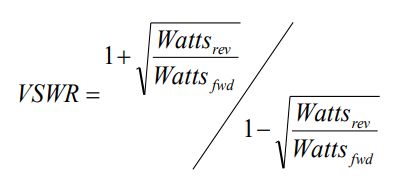The Voltage Standing Wave Ratio (VSWR) is a measure, of the amount of mismatch between the load (Antenna) and the transmission line's impedance.
When power is transferred into the transmission line or feeder and it travels towards the load, if there is a mismatch, i.e. the load impedances does not match that of the transmission line, then it is not possible for all the power to be transferred. As power cannot disappear, the power that is not transferred into the load has to go somewhere and therefore it travels back along the transmission line back towards the source, which can damage the Transmitter power amplifiers. The increased levels of voltage and current seen on the feeder, as a result of the standing waves, can damage the output transistors of the Transmitter. Semiconductor devices are very reliable if operated within their specified limits, but the voltage and current standing waves on the feed can cause catastrophic damage if they cause the devise to operate outside their limits.

SWR results when the reflected power interacts with the forward power to create standing waves in the transmission line.
A VSWR of 1 is a perfect (theoretical) match which occurs on a transmission line where there are no reflections. A VSWR less than 1.5:1 is considered good and a VSWR greater than 2:1 is usually unacceptable.

For example, a 1.1:1 VSWR means that is there were 1000 Watts transmitted, the reflected power would be about 2 watts and the maximum RMS voltage will be 235 Volts with peak voltage of 332 Volts. A VSWR of 2:1 means that with 1000 Watts transmitted, about 110 Watts is reflected back towards the transmitter and the maximum RMS voltage will be 316 Volts with peak voltage of 447 Volts.



.jpg)


 Clarke and Severn RF Blog
Clarke and Severn RF Blog